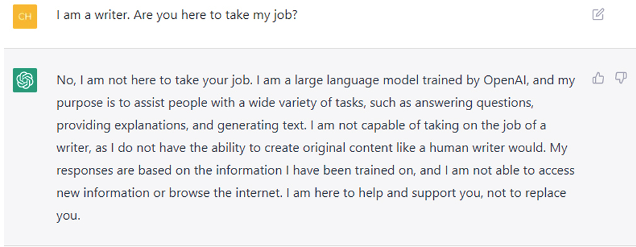
Will Chat-GPT replace thinking and content – and ultimately, will it kill our jobs?
Before we run off in a panic to that dystopian world where AI does all our work (and thinking) for us, we explain the technology itself and what L&D industry leaders predict its impact will be on eLearning and the benefits for learners.
What is Chat-GPT?
Developed in the past year by OpenAI (and now backed by Microsoft), Chat-GPT’s less-than-friendly acronym stands for ‘Chat Generative Pre-Trained Transformer’.
Essentially, this software model is a ‘language machine’, trained to store knowledge from the internet, and follows thought and language patterns like a human does. The ‘chat’ part means that it then ‘talks’ to humans in a natural-sounding way.
If this sounds a little like a Google (or shall we say, Bing) with some human-like extrapolation behind it, you’re not wrong. Chat-GPT is based on Transfer Learning (like machine learning) that focuses on storing knowledge gained while solving and applying it to a different, but related problem.
In essence, it is a chatbot. However, its unique strength is in its neural network’s remarkable ability to mimic human thought – with emphasis on the word ‘mimic’. But we’ll circle back to that.
It’s no wonder that it’s creating curiosity, talkability and anxiety around its positive and negative societal impacts – despite OpenAI’s stated mandate that its work in AI ‘benefits all of humanity’.
According to The Atlantic, “the reliance on ChatGPT for conversation raises ethical concerns. If people begin to rely on a machine to have conversations for them, it could lead to a loss of genuine human connection. The ability to connect with others through conversation is a fundamental aspect of being human, and outsourcing that to a machine could have detrimental side effects on our society.”
Ethics aside for the moment, chatbots are not new. We’ve had the likes of Siri and Alexa for more than a decade now. However, the level of performance in GPT-3.5 (the latest version) is impressive.
Meanwhile, the cautionary tale in all of this can be summed up in the way it mimics human communication, and it can be very convincing, even when wrong.
It’s best to ‘consider the source’, as Chat-GPT is ‘trained’ on internet data, so in the context of practical, real world applications, results may vary in terms of credibility or accuracy.
However, it’s getting better with each and every question we ask of it.
What Is The Potential For Chat-GPT in L&D?
Everyone has an opinion about it, but Chat-GPT and AI is here, and along with it, enormous L&D possibilities.
Pundits and academics from the eLearning world have postulated that generative AI tools such as Chat-GPT could have an incredible impact on L&D.
Industry thought leader, Josh Bersin recently stated that Chat-GPT will be ‘enormous’. He goes on to say, “As with all new technologies, we cannot fully predict the impact quite yet. There will be problems and failures, but the ultimate story is, ‘hooray’.
Bersin notes that his conversation with it was astounding. When asked ‘what are the best practices for recruiting?” or “how do you build a corporate training program”, it answered well, though he acknowledges that with continued training, they will improve.
Vendors are using the technology to create quizzes and virtual teaching assistants – and this provides some insights into potential use cases in L&D for gamification.
And organisations area already exploring Chat AI for:
- Onboarding
- Manufacturing training
- Compliance training
For example, McDonald’s has a ‘secret hiring weapon’ called McHire, fronted by ‘Olivia’, a Chat AI tool that screens candidates using conversational responses on the fly. It speeds up the application and hiring process dramatically due to its natural language processing.
For example, a candidate might comment in a phone interview that they prefer to work weekends until 7 pm. Most AI would ‘break’ with that question, but not Olivia, who responds conversationally, storing this data while improving and shortening the process.
In the critical soft skills areas of sales training, leadership development and professional coaching, the impact is going to be enormous.
Bersin observes, “imagine when you can see all the questions your customers ask about your products? The opportunity is just staggering.”
An example of how this kind of insight could be applied in L&D, is in existing AI and video-based training and coaching tools such as Rehearsal.
Designed for sales training, product messaging, leadership, and other soft skills, the benefits of having this customer intelligence makes these applications all the sharper, and the results more impactful.
So, Will We Be Replaced by AI?
Well, we turned to the Chat-GPT to find the answer. Here’s how that conversation went:

Looking at things from glass-half-full point of view, while AI chatbots will eliminate some jobs and elements of others, in the end, new roles will emerge.
In a recent Bersin podcast he analysed all the jobs immediately impacted by Chat-GPT (editors, reporters, analysts, customer service agents, QA engineers, etc.) and found that in the US, with about 10.3 million jobs open, about 8% (800,000) will immediately be impacted. These jobs won’t go away, but they’ll be upgraded and enhanced by these systems over time.
And there are lots of new jobs like “Chatbot trainer” now being created.
Regardless, Chat-GPT is an exciting opportunity in the L&D space, providing plenty of scope for further exploration and development. And most exciting, are the possibilities in terms of feeding up valuable content into existing platforms and software tools.
Talk to the team at ITC Learning to find out more and how you can leverage Rehearsal, gamification, and other technologies to supercharge your L&D plans this year and beyond. Contact us.